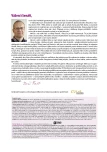How to properly classify female sexual dysfunctions?
Authors:
MUDr. Zlatko Pastor, Ph.D. 1,2,3
Authors‘ workplace:
Nestátní zdravotnické zařízení GONA, Praha, primář MUDr. Zlatko Pastor, Ph. D.
1; Sexuologický ústav 1. LF UK a VFN, Praha, přednosta doc. MUDr. Michal Pohanka, Ph. D.
2; Gynekologicko-porodnická klinika 2. LF UK a FN v Motole, Praha, přednosta prof. MUDr. Lukáš Rob, CSc.
3
Published in:
Prakt Gyn 2015; 19(1): 60-65
Category:
Sexuology: Review Article
Overview
Female sexual dysfunctions involve heterogenous range of problems, which may decrease quality of life, and bring interpersonal, relationship and reproductive issues. Its precise etiopathogenesis is not mostly known. They are characterized by phenomenological methods and divided by symptomatology. The article compares three current international female sexual dysfunction classification systems based on the type of their definition. Their mutual compatibility is critically evaluated and differences in approach to these issues are highlighted. Particular emphasis is placed on the evaluation of sexual dysfunction set by new revised version of the Diagnostic and Statistical Manual of Mental Disorders (51,2,3 th Edition). Overview and comparison of current classifications should contribute to a better use of these systems in clinical practice.
Key words:
classification – diagnostic and statistical manual – female sexual dysfunctions
Sources
1. ICD-10. International Statistical Classification of Diseases and Related Health Problems. 10th rev. World Health Organisation: Geneva 1992. Vol 1 Tabular List .ISBN 92 4 154419 8. Vol 2 Instruction Manual. ISBN 92 4 154420 1. Vol 3 Alphabetical Index ISBN 92 4 1544421 X.
2. Basson R, Leiblum S, Brotto L et al. Definitions of women’s sexual dysfunctions reconsidered: Advocating expansion and revision. J Psychosom Obstet Gynaecol 2003; 24(4): 221–229.
3. DSM-5. Diagnostic and statistical manual of mental disorders. 5th ed. American Psychiatric Association: Arlington (VA) 2013. ISBN 978–0-89042–556–5.
4. Lue TF, Giulano F, Montorsi F et al. Sexual dysfunctions in men and women. J Sex Med 2004; 1(1): 6–23.
5. Ko Y, Lin SJ, Salmon JW et al. The impact of urinary incontinence on quality of life of the elderly. Am J Manag Care 2005; 11(4 Suppl): S103-S111.
6. Laumann EO, Paik A, Rosen RC. Sexual dysfunction in the United States: prevalence and predictors. JAMA 1999; 281(6): 537–544.
7. Hollá K, Ježek S, Weiss P et al. The prevalence and risk factors of sexual dysfunction amongst Czech women. Int J Sex H 2012; 24(3): 218–225.
8. Masters W, Johnson W. Human sexual response. Little Brown Co: Boston (MA) 1966.
9. Kaplan HS. Disorders of Sexual Desire and Other New Concepts and Techniques in Sex Therapy. Brunner/Hazel Publications: New York 1979. ISBN 978–0702008023.
10. Third International Consultation on Sexual Medicine. Paris 10–13 July 2009. Health Publication Ltd 2010. Dostupné z WWW: <http://www.icud.info/PDFs/SEXUAL-MEDICINE-2010.pdf>.
11. Derogatis LR, Laan E, Brauer M et al. Responses to the proposed DSM-V changes. J Sex Med 2010; 7(6): 1998–2014.
12. Basson R, Wierman ME, van Lankveld J et al. Summary of the recommendations. J Sex Med 2010; 7(1 Pt 2): 314–326.
13. Basson R, Althof S, Davis S et al. Summary of the recommendations on sexual dysfunction in women. J Sex Med 2004; 1(1): 24–34.
14. Brotto LA, Graham CA, Binik YM et al. Should sexual desire and arousal disorders in women be merged? A response to DeRogatis, Clayton, Rosen, Sand, and Pyke (2010). Arch Sex Behav 2010; 12. Dostupné z DOI: <http://dx.doi.org/10.1007/s10508–010–9706–0>.
15. Cain VS, Johannes CB, Avis NE et al. Sexual functioning and practices in a multiethnic study of midlife women: Baseline results from SWAN. J Sex Res 2003; 40(3): 266–276.
16. Avis NE, Zhao X, Johannes CB et al. Correlates of sexual function among multi-ethnic middle-aged women: Results from the study of women’s health across the nation (SWAN). Menopause 2005; 12(4): 385–398.
17. Beck JG, Bozman AW, Qualtrough T. The experience of sexual desire: Psychological correlates in a college sample. J Sex Res 1991; 28(3): 443–456.
18. O’Sullivan LF, Allgeier ER. Feigning sexual desire: Consenting to unwanted sexual activity in heterosexual dating relationships. J Sex Res 1998; 35(3): 234–243.
19. Brotto LA, Heiman JR, Tolman DL. Narratives of desire in mid-age women with and without arousal difficulties. J Sex Res 2009; 46(5): 387–398.
20. Graham CA, Sanders SA, Milhausen RR et al. Turning on and turning off: A focus group study of the factors that affect women’s sexual arousal. Arch Sex Behav 2004; 33(6): 527–538.
21. Graham CA. The DSM diagnostic criteria for female sexual arousal disorder. Arch Sex Behav 2010; 39(2): 240–255.
Labels
Paediatric gynaecology Gynaecology and obstetrics Reproduction medicineArticle was published in
Practical Gynecology

2015 Issue 1
Most read in this issue
- New classification of breast tumors and lesions, their hormonal sensitivity a and our possibilities of prevention
- Metformin and pregnancy
- Role of D-mannose in the treatment and prevention of urinary infections
- Adenocarcinoma in situ of the uterine cervix –10-year series
